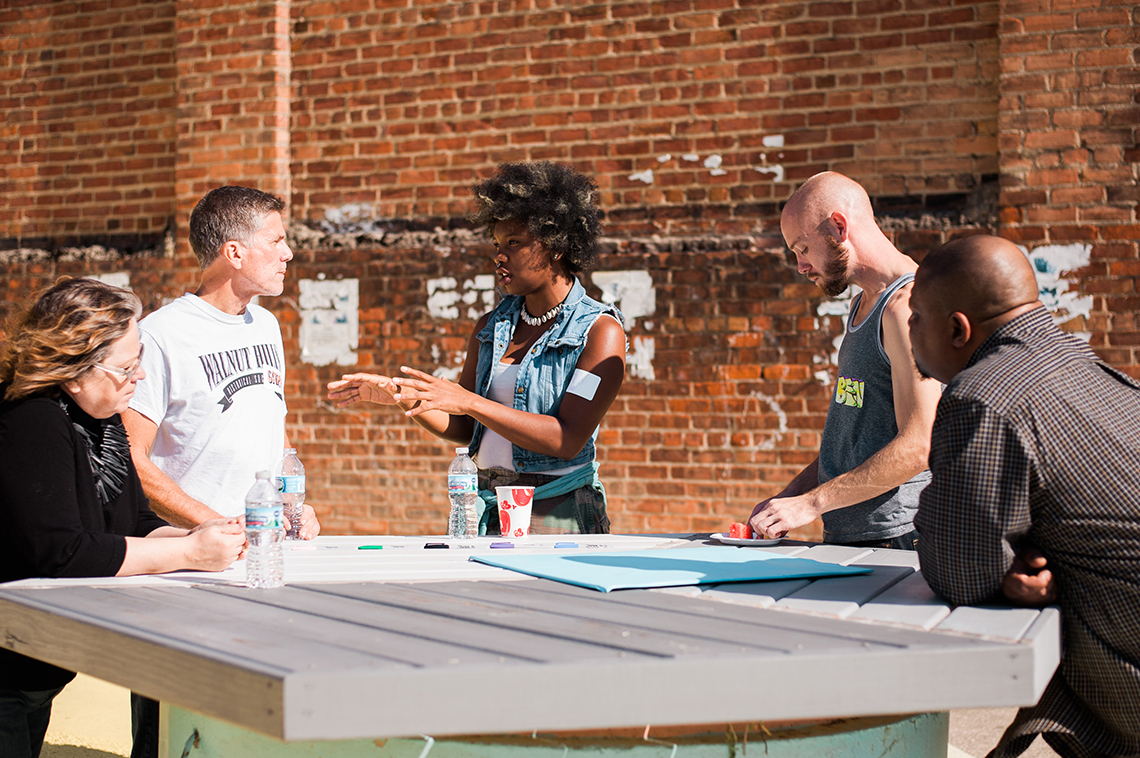
Creative placemaking is a powerful tool for helping residents shape the future of their neighborhood. This tool, though, is best leveraged when different residents are represented. Unfortunately, many communities face a similar problem: the same people participate in community engagement, and the same hard-to-reach residents are missing from the conversations. So how do we, as artists and community practitioners, ensure the priorities and hopes of residents are authentically represented when we set creative placemaking strategies? In Cincinnati, we struggled with this very question. The Walnut Hills neighborhood in particular was seeing a dramatic increase in new development and investment, but with it, this diverse, historic neighborhood was also seeing displacement and disengagement of some of its longstanding residents. Last year, several organizations were eager to explore this question. The Walnut Hills Redevelopment Foundation (RF), Local Initiative Support Corporation of Greater Cincinnati and Northern Kentucky and United Way of Greater Cincinnati were not only interested in reaching disengaged residents, but also bringing artists and residents together to initiate a creative placemaking project.
Our organization, Design Impact, was invited to lead this work by using design thinking, a problem-solving process that places the community’s needs, wants and aspirations in constant focus. As a nonprofit social innovation firm, we had often used design thinking to uncover community-driven solutions to issues like homelessness and poverty, but creative placemaking was a new focus for us.
This creative, empathy-driven approach not only helped us reach residents who were disconnected from neighborhood development, but it allowed us to generate new, different ideas around issues identified by residents. This process ultimately resulted in “High Fives,” a project designed and led by residents. High Fives allows residents to connect with and celebrate their neighbors through fun, creative yard signs that can be decorated with positive messages.
Through this work, we’ve found that the design thinking process can strengthen creative placemaking strategies in three key ways:
1) Design thinking recognizes multiple perspectives.
We met with residents one-on-one and in small group conversations in the places they felt most comfortable, like their homes or the local rec center. These intimate conversations, which focused on listening to their experiences rather than collecting data, encouraged residents to be honest and open about their thoughts on the changes of the neighborhood, as well as what stopped them from participating in community events.
As a result, later brainstorming sessions held with residents and community leaders reflected the issues directly felt by the people we interviewed. For example, many residents said they didn’t know the new people moving into the neighborhood. They also expressed that neighborhood events seemed like they were always for the same people. As a result, one of the topics residents brainstormed was on “Inclusive Community Gatherings.” (The idea for High Fives came out of this group).
2) Design thinking breaks down assumptions.
Like many of us, neighborhood organizations like the RF had assumptions about why residents stayed away from community events and listening sessions. But by talking with those residents who weren’t participating, we discovered barriers that hadn’t been considered before. Many of the events weren’t physically accessible to Walnut Hills’ older residents. Other residents said they didn’t feel safe leaving their homes, or were afraid that by vocalizing their concerns they’d be labeled as “snitches.” Finally, some admitted that they thought attending these meetings would only encourage and accelerate the gentrification of their neighborhood.
These new insights inspired the RF and DI to design engagements around High Fives in an entirely different way. Rather than host a planning session in a library or a church basement some evening, the RF set up a pop-up tent in a parklet in the middle of their business district.
People could see the event from the street, so they could easily walk up to ask questions or participate in the session as much or as little as they like.
3) Design thinking builds resident leadership.
There are two reasons design thinking can build resident leadership. First, it allows the experiences of those most impacted by the work to be prioritized throughout the process.
Design Impact takes it one step further by inviting those community members to be codesigners. This includes coming up with solutions alongside decision-makers, and then planning and implementing those solutions together. The idea for High Fives came from residents as a solution to a problem they had experienced first-hand: people in Walnut Hills wanted more ways to connect with – and celebrate – each other.
Second, design thinking is an action-oriented process that culminates in the testing of ideas quickly and cheaply in order to accelerate learning. It is different than piloting an entire program and introduces residents to early wins, improving the likelihood that those individuals will stay engaged.
High Fives was ultimately seen as a huge success for both the RF and Design Impact. Residents who hadn’t previously participated in listening sessions or community council meetings stepped up to plan what High Fives looked like, when it would happen and how to get other residents involved. Those who felt less comfortable leading tasks still contributed by spreading the word or distributing signs, a reminder that “resident leadership” can look different depending on the person.
Over a dozen other ideas from this process were developed with the Walnut Hills community, some of which will be part of the RF’s creative placemaking work moving forward.
To learn more about this project, read our case study or check out our recent photo essay. Or contact Sarah Corlett at sarah [at] d-impact.org.
This year Design Impact celebrated 10 years of work with the release of "A Decade of Work" impact report. Read it here.





